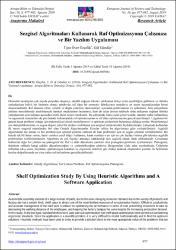| dc.contributor.author | Özçelik, Tijen Över | |
| dc.contributor.author | Gündüz, Gül | |
| dc.date.accessioned | 2023-11-21T11:39:53Z | |
| dc.date.available | 2023-11-21T11:39:53Z | |
| dc.date.issued | 2019 | en_US |
| dc.identifier.issn | 2148-2683 | |
| dc.identifier.uri | http://doi.org/10.31590/ejosat.606566 | |
| dc.identifier.uri | https://hdl.handle.net/20.500.12573/1834 | |
| dc.description.abstract | Otomobil montajının çok sayıda parçadan oluşması, sürekli değişen tüketici talebinden dolayı ürün çeşitliliğine gidilmesi ve fabrikayerleşkesinin belirli bir limitinin olması sebebiyle; raf alanı bir otomotiv fabrikasının neredeyse en sınırlı kaynaklarından birinioluşturmaktadır. Raf alanının etkin, verimli ve doğru yönetimi, hem maliyet açısından performansın en iyilenmesi, hem çalışanlarınyürüme mesafelerinin azaltılmasıyla hareket mudalarının önlenmesi, hem de artan üretim talebiyle ürün miktarına rağmen fabrikayerleşkesinin aynı kalması açısından kritik önem teşkil etmektedir. Bu çalışmada; kutu çeşidi çerçevesinde, standart raflar kullanılmışve ergonomik standartları da göz önünde bulundurarak raf optimizasyonu ve raf alanı optimizasyonu gerçekleştirilmiştir. Uygulama birgerçek hayat problemi olduğu için matematiksel olarak modellenmesi ve optimum çözümlerin bulunması oldukça zordur. Modellenmesizor olan problemelerin, en uygun değere yakın bir çözüm verebilmesi için sezgisel yöntemlerden faydalanılmıştır. Çalışmada kullanılanilk metot sezgisel metotlardan biri olan Greedy Algoritmasıdır. Kutular raflara bu algoritmaya göre yerleştirilmiştir. Açgözlüalgoritmalar her zaman ve her problem için optimal çözümü vermese de bazı problemler için en uygun çözümü vermektedirler. Birkerede tek bir karar verme, karar verirken yerel bilgiyi kullanma, karar verirken o an için en çok faydayı bulma gibi işlemler açgözlüprobleminin özelliklerindendir. Algoritma en çok faydayı aramaya odaklandığı için açgözlü olarak ifade edilmektedir. Çalışmadakullanılan diğer bir yöntem ise planogram’dır. Raf ve ürün düzenleme yazılımı olan planogram probleme uyarlanmıştır. Planogram;ürünlerin raflarda hangi şekilde düzenleneceğine ve yerleştirileceğine gösteren diyagramları ifade eden yazılımlardır. Ürünlerinraflardan çıkış sırası, boyutları, optimizasyon kuralları ve ergonomi kriterleri göz önüne alınarak oluşturulan yazılım ile belirlenenkısıtlar doğrultusunda en iyiye yakın raf yerleştirme gerçekleştirilmiştir. | en_US |
| dc.description.abstract | Automobile assembly consists of a large number of parts, due to the ever-changing consumer demand due to the variety of products and factory site has a certain limit; shelf space is almost one of the most limited resources of an automotive factory. Efficient, productivity and accurate management of the shelf area is critical for optimizing the performance in terms of cost, preventing movement breaks by decreasing the walking distance of the employees, and keeping the factory campus the same despite the increasing production demand. In this study; In the box type, standard shelves were used and rack optimization and shelf space optimization were carried out considering ergonomic standards. Since the application is a real-life problem, it is very difficult to model mathematically and to find the optimum solutions. Heuristic methods have been used in order to provide a solution close to the most appropriate value of the problems that are difficult to model. The first method used in the study is the Greedy Algorithm, which is one of the heuristic methods. Boxes are placed on shelves according to this algorithm. Although Greedy Algorithms do not always provide the optimal solution for every problem, they provide the most suitable solution for some problems. Making one decision at a time, using local information in the decisionmaking process, such as finding the most useful for the decision-making process is a feature of the Greedy problem. The algorithm is expressed as Greedy because it focuses on seeking the most benefit. Another method used in the study is the Planogram. The shelf and product layout software, Planogram, is adapted to the problem. Planogram; software that expresses diagrams showing how products are arranged and placed on shelves. The best possible shelf placement was carried out in line with the constraints determined by the software created by taking into consideration the order, dimensions, optimization rules and ergonomics criteria of the products. | en_US |
| dc.language.iso | tur | en_US |
| dc.publisher | Osman Sağdıç | en_US |
| dc.relation.isversionof | 10.31590/ejosat.606566 | en_US |
| dc.rights | info:eu-repo/semantics/openAccess | en_US |
| dc.subject | Greedy Algoritması | en_US |
| dc.subject | Sırt Çantası Problemi | en_US |
| dc.subject | Raf Optimizasyonu | en_US |
| dc.subject | Planogram | en_US |
| dc.subject | Greedy Algorithm | en_US |
| dc.subject | Knapsack Problem | en_US |
| dc.subject | Shelf Optimization | en_US |
| dc.title | Sezgisel Algoritmaları Kullanarak Raf Optimizasyonu Çalışması ve Bir Yazılım Uygulaması | en_US |
| dc.title.alternative | Shelf Optimization Study By Using Heuristic Algorithms and A Software Application | en_US |
| dc.type | article | en_US |
| dc.contributor.department | AGÜ, Mühendislik Fakültesi, Endüstri Mühendisliği Bölümü | en_US |
| dc.contributor.authorID | 0000-0001-7463-3458 | en_US |
| dc.contributor.institutionauthor | Gündüz, Gül | |
| dc.identifier.volume | 0 | en_US |
| dc.identifier.issue | 16 | en_US |
| dc.identifier.startpage | 977 | en_US |
| dc.identifier.endpage | 982 | en_US |
| dc.relation.journal | Avrupa Bilim ve Teknoloji Dergisi: European Journal of Science and Technology | en_US |
| dc.relation.publicationcategory | Makale - Uluslararası Hakemli Dergi - Kurum Öğretim Elemanı | en_US |


















